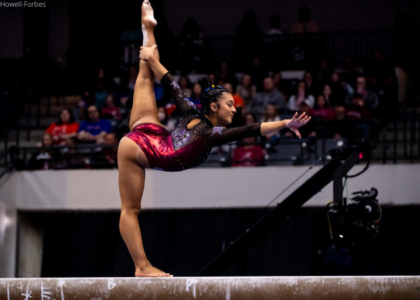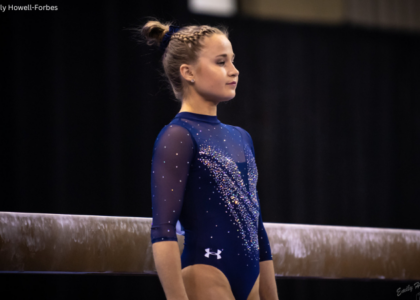It’s an all too familiar tale within the plot of the postseason: Your favorite team goes up on beam first in the regional final, hoping to upset gymnastics blue bloods to advance to nationals, only to score five mid 9.7s in a row and take itself out of contention before the competition even really begins. But is this tendency a fluke? Does starting on beam—or any other event for that matter—truly affect a team’s chances of finding success during the postseason?
That inference can certainly be drawn, a product of the nerves of competing not only to win but not to be eliminated, and the comfort of competing in the familiar Olympic order. But does this inference have statistical proof to back it up? Luckily, the (somewhat) random draw of the rotation order for postseason allows for this to be tested to determine whether starting on an event truly puts a damper on a team’s championship dreams.
For this analysis, we took every postseason full team score from the NCAA tournament dating back to 2016, excluding the play-in rounds from 2019 on. We removed any major outliers from the analysis, aka any performance that was more than 1.5 points away from the team’s NQS for that year. We then compared the deviance of the teams’ overall performance from their NQS to a categorical value for the event they started on, and statistically analyzed whether the event they started on was statistically significant to the deviation of their performance from the norm.
An easy visual for comparing a team’s performance to its starting event is a boxplot showing how an average performance deviated from NQS based on what event it started on. For the most part, all of these events hover around a team doing about two and a half tenths worse than its NQS value. This makes sense as the median postseason performance, based on the same data we are using, deviates about two tenths less than a team’s NQS.
The boxes on these boxplots essentially indicate where the middle 50% of values for each event fall. Since vault and beam have larger boxes than bars and floor, we can extrapolate that starting on these events can lead to a greater range of deviation from a team’s typical scoring performance. However, since the average deviations across all events are similar, we can predict that starting on a certain event does not have an effect on performance.
When the numbers are run, the analysis backs this theory and proves that there is not a significant impact on the deviation of a team’s performance from their norm between each event. Essentially, the event a team starts on has no significant effect on whether its performance will be deviated from the norm.
This shifted the target of the investigation into a more pairwise focused analysis, being which starting events create the most opportunity for a positive effect on a team’s performance compared to another? I analyzed each event against the other three possibilities (aka floor against vault, bars, and beam, vault against bars, beam, and floor, etc.), and sought to find which pair created the largest opportunity for differences in performance between two teams.
The difference values are the most important here, signaling (on average) how much higher or lower a team starting on an event will have its performance differ from the norm compared to starting on another event. For example, a randomly sampled team starting on beam in the postseason can be predicted to deviate 0.114 points higher (so improving on their NQS score by 0.114) than a team that starts on bars. Not what you would’ve predicted? Somehow, bars is the lonely child of the postseason events, where starting on any other event gives you a tiny, yet positive, advantage.
Although there is no event that has statistically proven itself to be a disadvantage to start on over the years in the postseason, when events are compared directly to one another, starting on bars reveals itself as the draw a team may want to avoid. So, which teams should be slightly wary going into the regional rounds in 2023? Georgia, Minnesota, Stanford, Southern Utah, Arkansas, and Illinois all start on the bars. While none of these teams are the top seed of their respective semifinals, it’s still a factor to keep an eye on as you watch the 2023 postseason unfold.
READ THIS NEXT: Data Deep Dive: Simulating the 2023 Postseason
Article by Emma Hammerstrom
Like what you see? Consider donating to support our efforts throughout the year! [wpedon id=”13158″]





Very interesting. Thank you for running the numbers! What I really wonder about is a team starting or ending on their best or worst event. 2018 comes to mind with UCLA finishing on beam, one of if not their best event. Clutching the title with those 10s. As scores typically build throughout the night I wonder if finishing on your best event is an advantage as judges will throw those really high scores (10s). Or is finishing on your worst even better since scores have trended upwards and maybe you can score a bit higher than you otherwise would?
Great idea! We will consider this for a follow-up article!